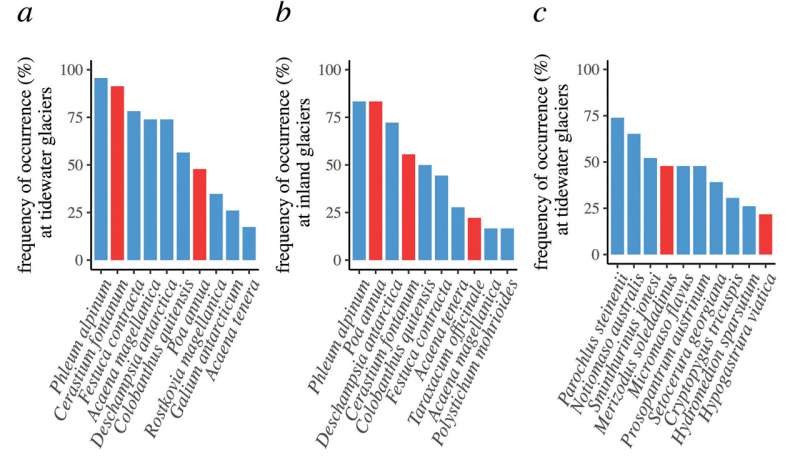This article has been reviewed according to Science X's editorial process and policies. Editors have highlighted the following attributes while ensuring the content's credibility:
fact-checked
peer-reviewed publication
trusted source
proofread
Melting glaciers in a warmer climate provide new ground for invasive species

Invasive species have rapidly colonized new ground exposed by melting glaciers in the sub-Antarctic island of South Georgia, according to new research.
Invasive species brought to new territories through human activities are one of the main causes of the ongoing biodiversity crisis. Even on South Georgia, a remote island located in the very south of the Atlantic Ocean, exotic species are present.
In a new study published in Neobiota the researchers Pierre Tichit (Durham University, now Swedish Agricultural University), Paul Brickle (South Atlantic Environmental Research Institute), Rosemary Newton (Royal Botanic Gardens, Kew), Peter Convey (British Antarctic Survey) and Wayne Dawson (Durham University, now University of Liverpool) look at how living organisms colonize new ground provided by melting glaciers on the British overseas territory.
Whalers and sealers inadvertently introduced many in the 19th and early 20th centuries. Like other cold regions of the world, South Georgia has another problem: many of its glaciers are melting at a fast pace because of climate change, leaving behind large areas of newly uncovered bare ground.
The authors surveyed the foreland biodiversity of six glaciers by counting plants, turning rocks, laying traps, and using sweep nets, enabling an inventory of the flora and fauna that colonize forelands at different stages of their retreat.
Their results indicate that invasive species will likely spread on South Georgia as fast as glaciers are retreating. Whether this has or will have negative consequences on local species needs to be investigated to help protect this unique ecosystem.
Just a few years after the bare ground is exposed to glacier melting, pioneer plants arrive, progressively covering more ground with time and followed by an increasing number of species. The study discovered that not only native but also exotic plants and invertebrates are taking advantage of this opportunity. Even more surprising, two temperate plant species from the Northern Hemisphere, annual meadow grass and mouse-ear chickweed, colonized sites faster than any other species.
Scientific expeditions to such an isolated and inhospitable island are challenging. The crossing from the Falkland Islands to reach South Georgia takes several days on a notoriously temperamental ocean. Once on the island, most glaciers are only accessible with small boats followed by hikes through difficult terrain.
More information: Pierre Tichit et al, Introduced species infiltrate recent stages of succession after glacial retreat on sub-Antarctic South Georgia, NeoBiota (2024). DOI: 10.3897/neobiota.92.117226
Journal information: NeoBiota
Provided by Pensoft Publishers



















